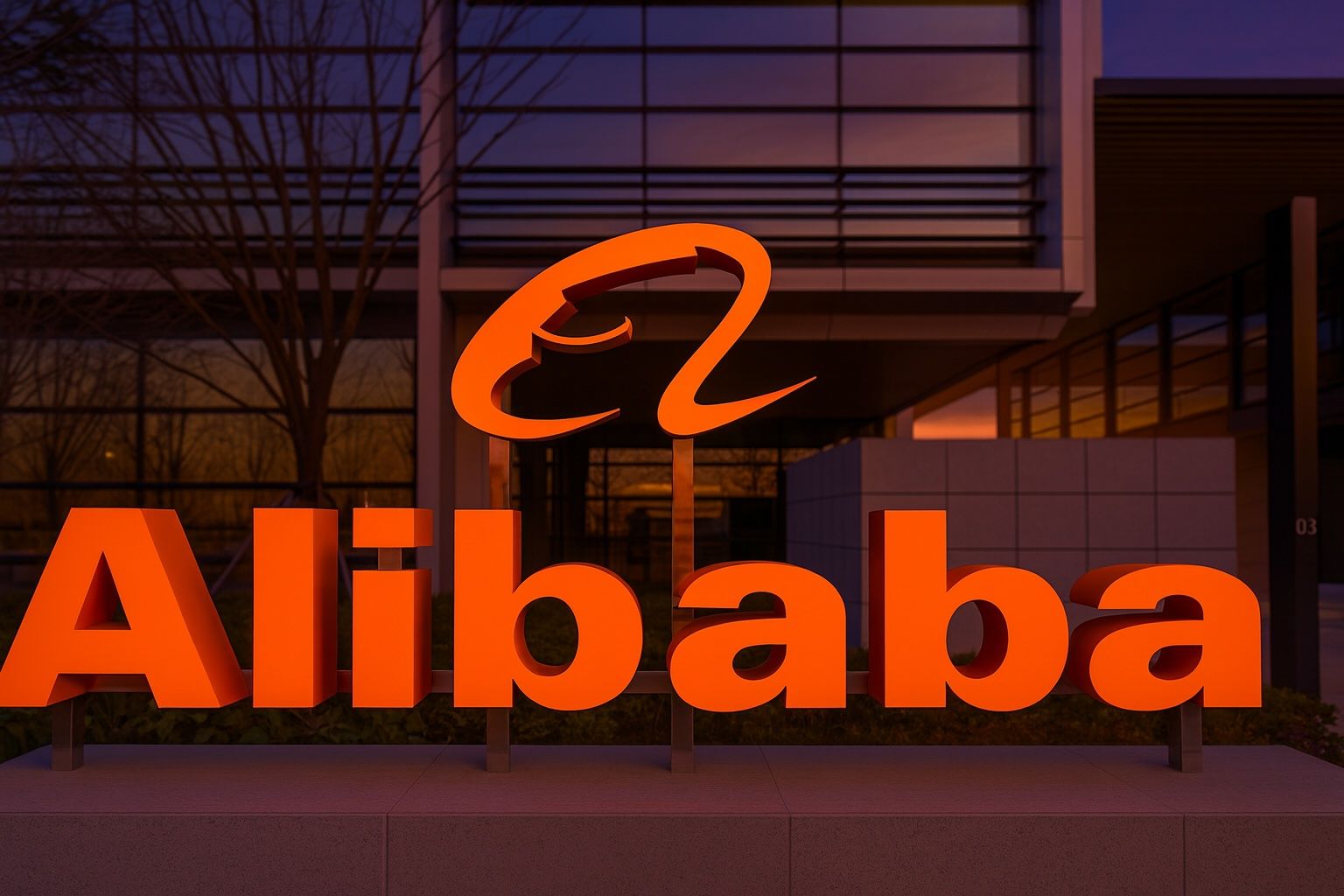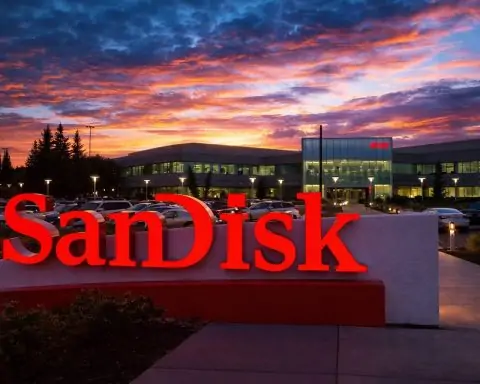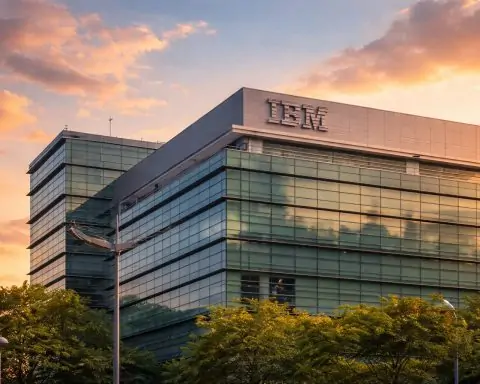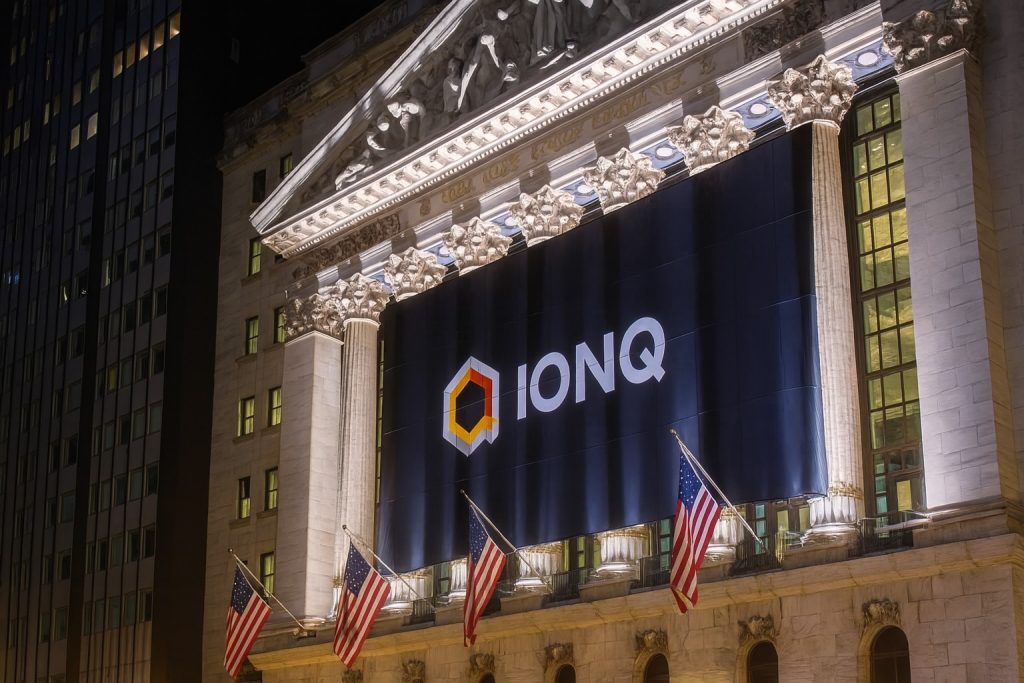- BABA stock trades around the mid-$160s on October 20, 2025, near its highest level since 2019 and up roughly 85–97% year-to-date [1] [2].
- Alibaba’s aggressive push into artificial intelligence and cloud computing has fueled investor optimism, with cloud revenue jumping +26% last quarter and management pledging a ¥380 billion (~$53 billion) tech investment spree [3].
- Recent catalysts include major AI initiatives and strategic deals: unveiling a 1-trillion-parameter AI model with NVIDIA partnerships, a new multi-year NBA China pact, expanded cloud data centers overseas, and a record ¥50 billion Singles’ Day discount campaign [4] [5].
- China’s regulatory crackdown has eased, lifting a shadow over Alibaba – though U.S.–China tensions (export chip controls, tariff threats) sparked volatility in October [6] [7].
- Technical trends remain bullish: Alibaba’s share price broke out above key resistance, formed a “golden cross” of its moving averages, and is holding support around the $160 level [8] [9].
- Analysts are overwhelmingly bullish – 17 Buy ratings vs just 1 Hold – with 12-month price targets averaging in the high-$180s and top calls as high as $230–$240, citing Alibaba’s AI-driven resurgence [10] [11].
BABA Stock Soars in 2025: Latest Price and Performance
Alibaba Group Holding’s U.S. shares (NYSE: BABA) are trading around $166 as of Monday, October 20, 2025 – hovering near their highest levels in four years [12]. The stock has roughly doubled in 2025, vastly outperforming broader indices. Year-to-date, BABA is up about 85–97% in value [13] [14], making it one of the top tech rebound stories of the year. By comparison, the NYSE Composite index has gained only ~12% in 2025 [15]. Alibaba’s ADR price hit the mid-$170s earlier this month – territory not seen since 2019 – before a brief pullback. Over the past week, shares have been volatile but largely steady: after a mid-week dip on trade war fears, BABA rebounded and is essentially flat versus last Friday [16] [17]. In Hong Kong, Alibaba’s secondary listing (9988.HK) similarly bounced ~5% on Monday after a sharp drop late last week, reflecting improving sentiment after initial jitters.
This dramatic 2025 rally marks a sharp turnaround from the prior two years, when Chinese tech stocks languished under regulatory crackdowns and economic uncertainty. Alibaba’s market capitalization has swelled to around HK$3.4 trillion (>$430 billion) [18], putting it in contention again among Asia’s most valuable companies. “The narrative of Alibaba in 2025 is one of doubling down on innovation and expansion… pouring resources into next-gen AI technology,” observed TS² Tech News, noting that this bold strategy “sparked a rally” in Alibaba’s shares [19]. Investors have clearly taken notice – even legendary value investor David Tepper reportedly made Alibaba his largest holding this year [20]. The question now is whether Alibaba’s stock surge can hold up or extend further, as the company navigates both new opportunities and lingering risks.
AI Ambitions and Cloud Growth Fuel Alibaba’s Rally
A core driver behind Alibaba’s stock resurgence is its pivot to artificial intelligence and cloud computing. Under CEO Eddie Wu – who took the helm in late 2023 – Alibaba has gone “all-in” on next-gen tech. The company has unveiled an ambitious three-year plan to invest ¥380 billion (US$53 billion) into AI development and cloud infrastructure [21]. This includes building out advanced AI models and data centers worldwide. At its annual Apsara tech conference in late September, Alibaba introduced Qwen-3 Max, a new 1-trillion-parameter AI model with capabilities on par with the world’s largest AI systems [22]. It also rolled out Qwen-3 Omni, a multimodal AI for vision/AR tasks, and announced collaborations with NVIDIA to co-develop AI chips and software [23]. This flurry of AI news triggered a late-September stock spike – Alibaba’s shares jumped ~8% in one day after the announcements [24] as investors bet on the company’s potential as an AI leader.
Alibaba’s cloud division is already seeing tangible gains from the AI push. In the June quarter (FY Q1 2026), cloud revenue surged +26% year-on-year, far outpacing the ~10% growth of Alibaba’s core e-commerce segment [25]. Demand for AI computing services has exploded in China, and Alibaba Cloud (recently rebranded as the Digital Technology and Intelligence Group) provides the backbone for many companies training large language models and generative AI. This cloud boom helped lift Alibaba’s total quarterly revenue by ~14% YoY to RMB 247.7 billion [26]. “Alibaba has re-emerged as an AI superpower in the making,” one analyst said, as Wall Street grows confident that the company’s years of R&D are bearing fruit [27]. Major banks like JPMorgan have taken note – in early October JPMorgan raised its 12-month price target for Alibaba by nearly 45%, citing a “growth inflection” from AI and cloud initiatives [28].
However, this tech-focused expansion comes at a short-term cost. Alibaba’s heavy spending on new AI projects, cloud infrastructure, and strategic subsidies has pressured its profit margins. Last quarter, operating income fell slightly (−3%) and adjusted EBITDA dropped 14% year-on-year [29] despite the sales gains. Angelo Zino, an analyst at CFRA, cautioned that Alibaba’s aggressive investments have “impacted profitability” in the near term [30]. The company is effectively accepting short-term pain for long-term gain – pouring money into future growth drivers like AI, even if it means slimmer margins today. Toby Xu, Alibaba’s CFO, acknowledged on the last earnings call that “profitability was impacted by growth initiatives” like user acquisition costs and tech R&D [31]. The good news for investors is that Alibaba can afford it: the firm still generated over $20 billion in net income in the past year and sits on $23 billion in net cash, giving it ample war chest to fund innovation [32]. It has even been aggressively buying back shares (nearly $12 billion repurchased in the last year) to return capital to shareholders [33]. In short, Alibaba’s AI-and-cloud gambit appears to be paying off in revenue growth, and the company’s financial strength provides a cushion while it chases longer-term opportunities.
New Deals, Expansion and E-Commerce Initiatives
Beyond AI, Alibaba has been making headlines with strategic deals and expansion efforts that bolster its growth narrative. Earlier this month, Alibaba announced a landmark partnership with the NBA in China. This multi-year deal – revealed on October 9 during NBA preseason games in Macau – makes Alibaba Cloud the NBA’s official cloud and AI partner in China [34]. Alibaba will provide cloud computing and AI services to enhance fan engagement on the NBA’s Chinese digital platforms [35]. The pact also underscores co-founder (and Brooklyn Nets owner) Joe Tsai’s role in mending the NBA–China relationship after a 4-year rift [36]. Investors cheered this as a savvy move showcasing Alibaba’s technology and influence in media/sports, with potential to drive cloud usage and consumer engagement.
At the same time, Alibaba is extending its global footprint. Just this week, Alibaba Cloud opened a second data center in Dubai, nine years after its first entry into the Middle East [37]. The new Dubai facility expands Alibaba’s cloud reach in a region witnessing rapid digital adoption. “The Middle East’s fast-tracking of AI adoption” is a key reason to invest there, an Alibaba Cloud executive noted [38]. This move comes as Gulf nations pour billions into tech; Alibaba’s massive $53 billion tech budget is helping fund such international expansions [39]. Similarly, Alibaba and its affiliate Ant Group just agreed to acquire a large office tower stake in Hong Kong – buying 13 floors of One Causeway Bay for $925 million [40]. The purchase (at a hefty 52% premium to the building’s last valuation) signals Alibaba’s confidence in its home market and its intent to deepen roots in Hong Kong as it reorganizes and spins off business units [41].
On the e-commerce front, Alibaba is gearing up for a crucial Singles’ Day shopping season amid a sluggish Chinese economy. Singles’ Day (November 11) is the world’s biggest online shopping festival, and Alibaba is pulling out all the stops to spur consumer spending. This year, Alibaba and rival JD.com are stretching Singles’ Day promotions to a record five weeks of sales and specials [42]. At a Shanghai press event on Oct. 16, Alibaba unveiled an “unprecedented” ¥50 billion (~$7 billion) in consumer subsidies and coupons for the festival [43]. It’s also rolling out new AI-driven interactive features to draw shoppers. These aggressive tactics aim to boost demand at a time when Chinese retail sales growth has cooled to ~3–4% [44]. By extending the shopping season and offering massive discounts, Alibaba hopes to entice cautious consumers to spend – even if it means sacrificing some margin. “This is a battle Meituan cannot afford to lose,” one analyst quipped about the escalating e-commerce and delivery price wars, underscoring how high the stakes are for market share [45]. For Alibaba, a successful Singles’ Day could provide a year-end revenue bump and justify the heavy promotions spend. Early indications are positive: in the first hours of pre-sales, hundreds of millions of yuan of merchandise were snapped up [46]. Investors will be watching closely to see if Alibaba’s bet on subsidies translates into sustained sales momentum – and whether management signals any improved consumer trends when it reports earnings next month.
Easing Regulatory Clouds Amid Geopolitical Tensions
Alibaba’s 2025 comeback has been aided by a much friendlier regulatory environment in China. From 2020 to 2022, Beijing’s tech “crackdown” hit Alibaba and its peers with antitrust fines, stricter data rules, and abrupt interventions (most famously, halting Ant Group’s IPO). Alibaba paid a record $2.8 billion antitrust fine in 2021 and was forced to implement reforms. Those days now appear to be in the rearview mirror [47]. Chinese authorities have markedly softened their stance this year, as they look to the tech sector to help revive economic growth. Officials have even referred to platform companies like Alibaba as crucial “growth engines” for the economy [48] – a stark change in tone from the crackdown era. Regulators have signaled that broad, punitive actions are over, focusing instead on more routine supervision. For example, earlier this month China’s Cyberspace Administration gave a mild reprimand to Alibaba’s UC Browser unit for some “harmful” online content, but notably Alibaba’s stock rose on that news [49]. Investors interpreted it as a minor compliance issue, not a return to heavy-handed enforcement. In fact, Alibaba has been actively cooperating with regulators – pledging to avoid predatory pricing and to “do our part to defend our market position” without violating fair competition rules [50]. By aligning with policy goals and avoiding new controversies, Alibaba seems to have escaped the regulatory doghouse. “The net news flow for Alibaba has been decisively positive in the past week… AI optimism far outweighing any residual regulatory noise,” noted TS², reflecting the newfound market confidence [51] [52].
That said, geopolitical and macroeconomic risks linger on the horizon. In particular, U.S.–China tensions have periodically jolted Alibaba’s stock, reminding investors that external factors can still bite. In early October, reports that the U.S. government would tighten export controls on advanced semiconductors sent Chinese tech shares tumbling. Stricter U.S. chip rules could hinder Alibaba’s AI efforts if it becomes harder to source cutting-edge NVIDIA GPUs – though Alibaba is developing in-house AI chips to mitigate this [53]. Around the same time, rhetoric of a revived trade war spooked markets. U.S. President Donald Trump threatened to reimpose 100% tariffs on Chinese goods by Nov. 1, raising fears of “Trade War 2.0” [54] [55]. Alibaba’s Hong Kong shares sank about 5% during that scare [56], and the company briefly lost over $30 billion in market cap in a single week-long slide [57]. However, sentiment quickly stabilized as many analysts argued the tariff threat was more bark than bite. One economist noted that the uncertainty felt like “a tariff scare rather than a full-blown collapse” in U.S.-China trade [58]. Indeed, by Oct. 17, dip-buyers had stepped in and Alibaba’s U.S. stock had erased its losses [59] [60]. Analysts expect these macro headwinds to be manageable unless they dramatically escalate [61]. Moreover, Alibaba’s growing international business (overseas revenue doubled to 13% of sales from 7% in 2021 [62] [63]) provides some buffer against China-specific issues. Still, the overhang of geopolitical risk means Alibaba’s stock could remain sensitive to any major news on U.S.-China relations, export policy, or China’s economic stimulus measures. Investors are hoping Beijing will introduce further economic support – such as consumer stimulus or rate cuts – to bolster spending, which would directly benefit Alibaba’s commerce empire [64].
Technical Analysis: Uptrend Intact, Key Levels to Watch
Alibaba’s stock charts are painting a decidedly bullish picture in 2025 after a long downtrend. Technical analysts point out that major resistance levels have been cleared. In September, BABA’s share price broke out above the $150–$160 zone, a range that had repeatedly capped rallies in 2022 and 2023 [65]. This breakout, accompanied by surging trading volume, decisively ended the stock’s two-year bear trend. In fact, the downward sloping trendline from Alibaba’s late-2020 highs was breached for the first time, signaling that the long slump is likely over (barring new shocks). Momentum indicators confirm the regime change: Alibaba’s 50-day moving average has crossed above its 200-day moving average, forming a classic “golden cross” pattern in recent months [66]. This bullish crossover often marks the transition to a sustained uptrend. Additionally, the stock has mostly traded above its short-term averages (20-day, 50-day) since spring, showing strong upward momentum across timeframes.
Short-term momentum oscillators did flash overbought signals during Alibaba’s rapid run-up. For instance, the Relative Strength Index (RSI) popped above 70 in late September amid the buying frenzy [67]. That typically suggests a need for consolidation – which indeed happened as the stock pulled back modestly in early October. These kinds of dips in an uptrend are normal and even healthy. Analysts note that as long as Alibaba’s RSI and other indicators cool off without a major price breakdown, it “resets” the stock for another potential leg higher [68]. As of mid-October, the RSI has eased back into the 50s–60s, a neutral zone that gives Alibaba room to rally again [69]. Importantly, buy-the-dip behavior has been evident: pullbacks have been met with relatively lower volume selling and renewed buying interest, suggesting institutions are accumulating shares on weakness [70].
Looking ahead, traders have clearly defined support and resistance levels. On the upside, the $180 area (around HK$180 for Hong Kong shares) stands out as a psychological resistance – Alibaba briefly poked into the high-$170s/low-$180s in early October but didn’t hold above it [71]. A decisive break past ~$180 would be a bullish signal, potentially opening the door to the next big target around $200. The $200 mark is not only a round number but roughly aligns with where Alibaba’s stock traded in mid-2019; it could act like a magnet if the rally resumes [72]. Beyond $200, technicians point to the 2020 all-time highs in the $230–250 range as a long-term aspirational target [73], though reaching that would likely require significantly more good news.
On the downside, previous resistance turns into new support. The ~$160 level that Alibaba cleared now becomes an important support floor [74]. Indeed, we’ve seen the stock dip toward the mid-$160s and quickly find buyers around there. A pullback into the $160–$170 zone that stabilizes would be viewed as a constructive base-building. Below that, the next support is around $150, which was a consolidation area earlier in the year and roughly where the 200-day moving average now sits [75]. Chartists say a drop below $150 would be a warning sign that the uptrend is faltering – something not expected unless there’s a major negative shift in fundamentals or macro conditions [76]. For now, the trend remains Alibaba’s friend: higher highs, higher lows, and strong volume on rallies indicate the path of least resistance is still upward [77]. As long as broader market conditions (especially in China) remain stable, technical analysts believe BABA stock has a good chance to continue its climb, with any near-term volatility offering potential entry points for dip buyers [78].
Wall Street’s View: Bullish Sentiment and Forecasts
Market analysts and investors are largely bullish on Alibaba’s prospects, though there is a range of views on how much upside remains. Virtually every major brokerage covering Alibaba has a positive rating on the stock. As of this month, 17 out of 18 analysts tracked rate BABA as a “Buy” or equivalent, with only a single Hold and zero Sell ratings [79]. This is one of the most bullish skews among big-cap tech stocks and reflects broad confidence in Alibaba’s trajectory. Such unanimous optimism provides a bit of a sentiment floor – it suggests that on any sizable dip, institutional investors might step in, trusting Alibaba’s long-term thesis [80].
Price target forecasts, however, show a more measured upside from current levels. According to a compilation of recent targets, the consensus 12-month price target for BABA’s U.S. shares is around $184 [81], only modestly above the mid-$160s. Many analysts essentially see Alibaba approaching fair value after its huge rally – “the stock is approaching price targets, implying the easy gains may be behind us,” as one might put it. Indeed, some valuation models flag the stock as no longer cheap: research platform Simply Wall St estimates Alibaba “might be 52% overvalued” relative to its DCF-based fair value [82]. These more cautious takes argue that Alibaba’s earnings need to catch up to the stock’s big re-rating. Skeptics … counter that macro and political risks are never far away, and that Alibaba’s stock might remain range-bound if earnings don’t accelerate enough to justify further multiple expansion, writes TS² [83], capturing the bear case.
On the other hand, top bullish analysts see significant room to run if Alibaba executes well. Several firms have hiked their targets in light of Alibaba’s AI potential and improving outlook. For example, JPMorgan now projects BABA’s ADRs could reach $240 (≈HK$1,960) by late 2026 [84] – effectively predicting new all-time highs in the next year or two. Jefferies is also upbeat with a $230 target [85], citing unlocked value from possible spin-offs (like a future IPO of Alibaba’s cloud unit) and a recovering Chinese economy [86]. CLSA recently lifted its target from $155 to $200 and reiterated an Outperform rating [87], implying they still see upside even after the stock’s big September run. Analysts at Goldman Sachs, Daiwa, and CICC likewise expressed optimism in October, pointing to Alibaba’s cloud growth, AI breakthroughs, and early signs of e-commerce recovery as key catalysts for further gains [88]. Notably, Goldman Sachs highlighted Alibaba as a top pick among Chinese companies “going global,” and said the stock’s 97% YTD surge is backed by fundamental improvements in its business (like overseas revenue doubling and cloud advances) [89] [90]. Analysts expect Alibaba’s revenue growth to accelerate into the high-teens percentage in the coming year (fiscal 2026), partly due to easier comparisons and a gradually stabilizing economy [91]. Consensus forecasts call for Alibaba’s earnings per share to grow ~15–20% annually over the next few years [92] – a reflection that margins may start improving again as some of these big investments pay off.
Looking further out, the long-term bull case for Alibaba is that it can transform into an even more diversified tech powerhouse, deserving of higher valuations. If cloud computing, international commerce, logistics, and AI-driven services become larger pieces of the pie (alongside its dominant domestic e-commerce and fintech arms), Alibaba’s sum-of-parts value could increase substantially. Some point to Amazon’s AWS as an analogy – despite being ~15% of Amazon’s revenue, AWS is arguably worth half of Amazon’s trillion-dollar market cap. Alibaba Cloud is about 10% of Alibaba’s revenue now and growing faster [93] [94]; bulls argue that as it scales and perhaps spins off, it could unlock significant value [95]. Likewise, businesses like Ant Group (fintech) and Cainiao (logistics) could eventually be monetized more fully through IPOs or listings, benefiting Alibaba shareholders.
Of course, to achieve those lofty outcomes, a lot needs to go right. Alibaba will need to navigate economic swings, execute on its AI ambitions, and avoid flare-ups in regulatory or political risk. In sum, analysts and experts are broadly positive about Alibaba’s direction [96]. The near-term outlook is for continued solid results and perhaps moderate upside into year-end, assuming no major external shocks. The company’s next earnings report (expected in November) will be a crucial checkpoint – investors will look for updates on consumer demand (Singles’ Day outlook), profit margins, and any guidance on how AI investments are translating into new revenue. If Alibaba delivers upside surprises or upbeat guidance, it could rekindle the rally into 2026. On the flip side, any signs of economic strain or disappointment in growth could reinforce the view that the stock’s best gains are already in the rearview. For now, Alibaba stands as a bellwether for China’s tech revival, and all eyes are on whether it can maintain its momentum in the coming months. As one market commentator put it, this year Alibaba is essentially “reinventing itself for the new era of AI-driven tech” – and investors are watching closely to see if that reinvention continues to pay off [97].
Sources: Alibaba & market data from TS² Technology News [98] [99], Reuters [100], Benzinga [101] [102], and analyst reports.
References
1. ts2.tech, 2. www.benzinga.com, 3. ts2.tech, 4. ts2.tech, 5. ts2.tech, 6. ts2.tech, 7. ts2.tech, 8. ts2.tech, 9. ts2.tech, 10. ts2.tech, 11. ts2.tech, 12. ts2.tech, 13. ts2.tech, 14. www.benzinga.com, 15. www.benzinga.com, 16. ts2.tech, 17. ts2.tech, 18. ts2.tech, 19. ts2.tech, 20. ts2.tech, 21. ts2.tech, 22. ts2.tech, 23. ts2.tech, 24. ts2.tech, 25. ts2.tech, 26. ts2.tech, 27. ts2.tech, 28. ts2.tech, 29. ts2.tech, 30. ts2.tech, 31. ts2.tech, 32. ts2.tech, 33. ts2.tech, 34. ts2.tech, 35. ts2.tech, 36. ts2.tech, 37. ts2.tech, 38. ts2.tech, 39. ts2.tech, 40. ts2.tech, 41. ts2.tech, 42. ts2.tech, 43. ts2.tech, 44. ts2.tech, 45. ts2.tech, 46. ts2.tech, 47. ts2.tech, 48. ts2.tech, 49. ts2.tech, 50. ts2.tech, 51. ts2.tech, 52. ts2.tech, 53. ts2.tech, 54. www.benzinga.com, 55. www.benzinga.com, 56. ts2.tech, 57. ts2.tech, 58. ts2.tech, 59. ts2.tech, 60. ts2.tech, 61. ts2.tech, 62. www.benzinga.com, 63. www.benzinga.com, 64. ts2.tech, 65. ts2.tech, 66. ts2.tech, 67. ts2.tech, 68. ts2.tech, 69. ts2.tech, 70. ts2.tech, 71. ts2.tech, 72. ts2.tech, 73. ts2.tech, 74. ts2.tech, 75. ts2.tech, 76. ts2.tech, 77. ts2.tech, 78. ts2.tech, 79. ts2.tech, 80. ts2.tech, 81. ts2.tech, 82. ts2.tech, 83. ts2.tech, 84. ts2.tech, 85. ts2.tech, 86. ts2.tech, 87. ts2.tech, 88. www.benzinga.com, 89. www.benzinga.com, 90. www.benzinga.com, 91. ts2.tech, 92. ts2.tech, 93. ts2.tech, 94. ts2.tech, 95. ts2.tech, 96. ts2.tech, 97. ts2.tech, 98. ts2.tech, 99. ts2.tech, 100. ts2.tech, 101. www.benzinga.com, 102. www.benzinga.com







